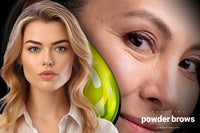11. Conclusions
Every typical needle cartridge package contains basic markers, such as diameter, number of needles, needle formation, and taper length. These markers are foundational knowledge for selecting the right needle for specific techniques.
The diameter of the needle, for instance, influences the flow of pigment into the skin, with larger diameters causing more saturation.
The number of needles and their formation, from Round Liners ideal for precise lines to Round Shaders for softer effects, dictate the texture and finish of the work. An artist should know those properties, whereas for powder in the powder brows procedure, often single needles are used (25 1 RL MT, for example).
The concept of machine stroke height, often categorized into short, medium, and long strokes, is instrumental in determining the depth and impact of the needle on the skin. Understanding that different machines may have varying definitions of these categories underlines the importance of referring to actual millimeter measurements for accuracy.
Regarding basic movements, we discussed the following. Pendulum - beneficial for beginners, involves the needle moving in both directions, though less effective for pixelation in powder brows. The Whip - allowing for precision, entails the needle touching the skin in one direction and returning without re-contact. Etching - where the needle continuously moves forward, deposits significant pigment, and is ideal for clear lines. Circle movement - involving overlapping circular motions, is effective for packing pigment and is used for injecting larger quantities of substances like saline-based removal gels.
An additional aspect is the distinction between cartridges and nozzles. While cartridges are commonly used for various techniques, nozzles offer a precision-focused alternative, particularly effective for fine, detailed work like thin hairstrokes, albeit less suitable for shading.
When it comes to machine speed, it has to match the artist’s hand speed. Dispelling myths about "correct" machine speeds, this article emphasizes the need for artists to develop a sense of how machine speed interacts with their style and the tools at their disposal.
Readers suggest






